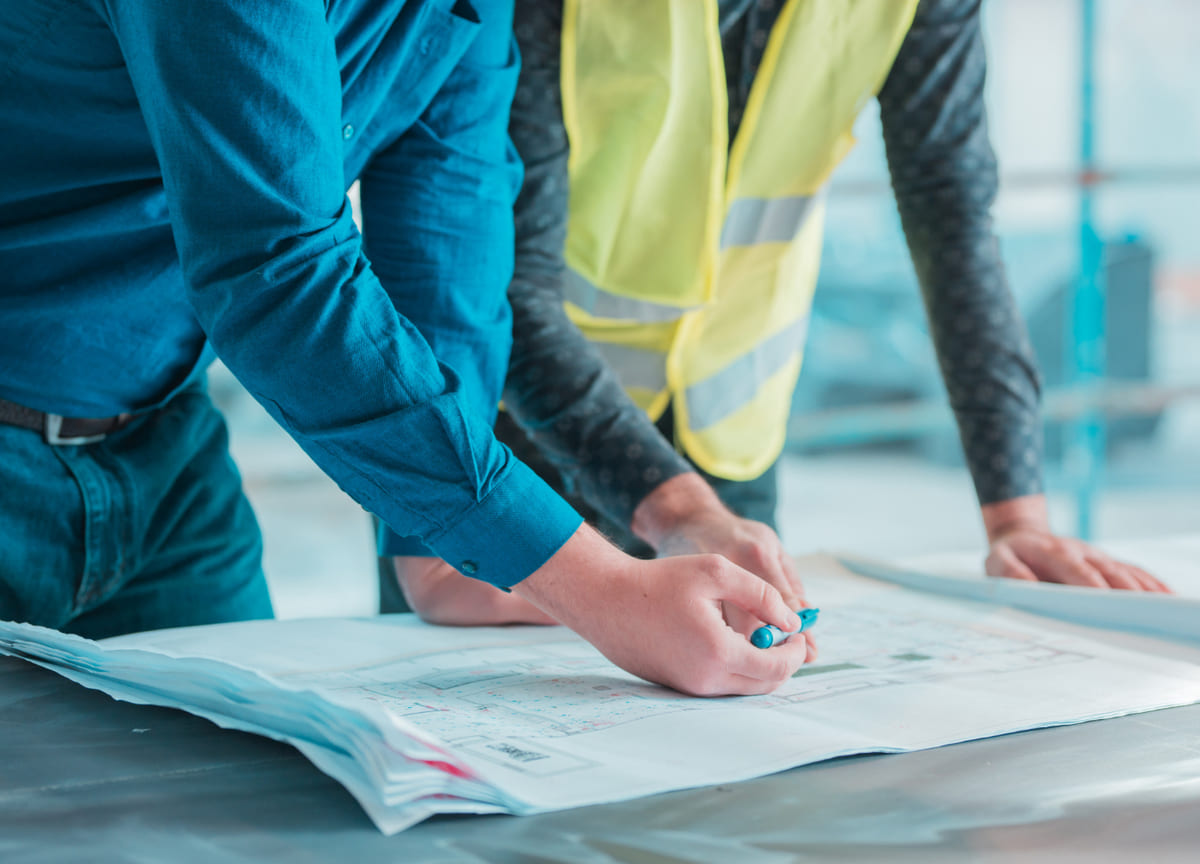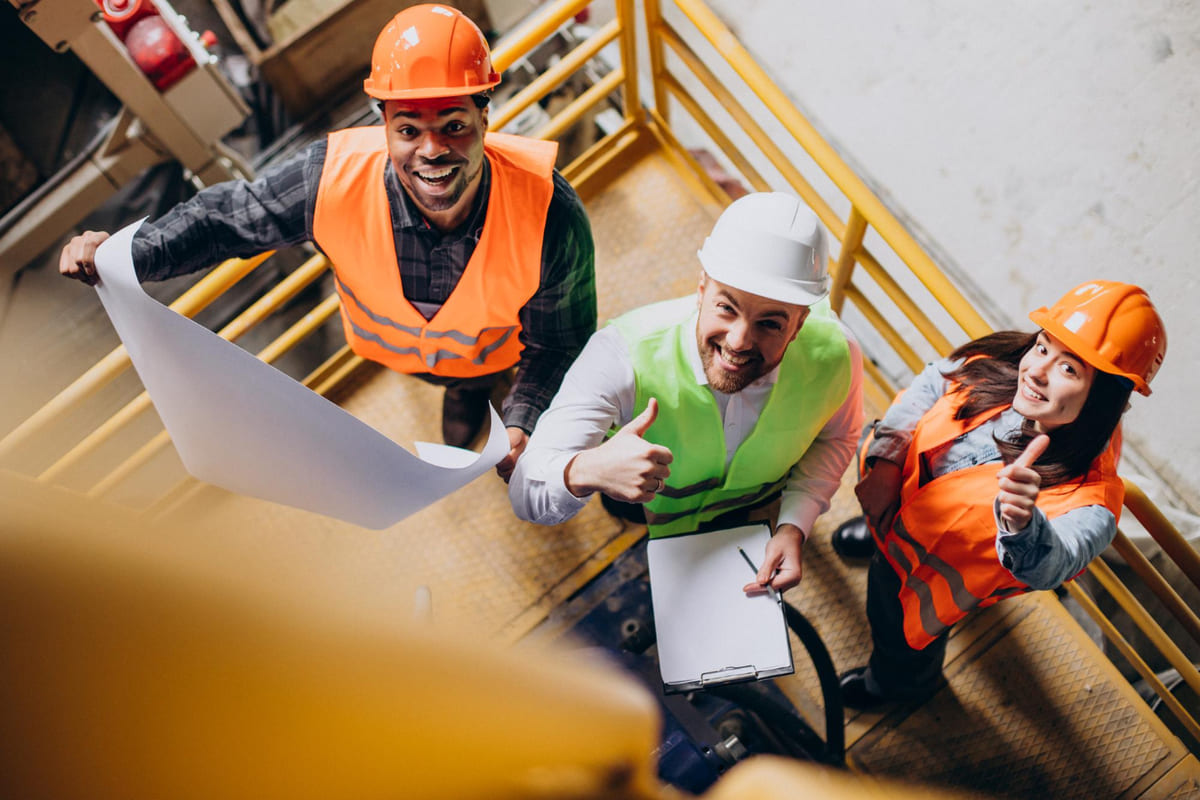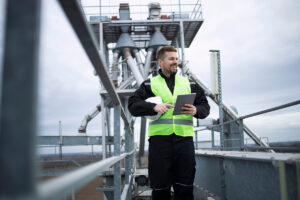Construction is a dangerous enterprise, with each project presenting unique problems and opportunities. One of the most critical components of a building project is identifying and managing opportunities and risks appropriately. If not addressed effectively, a risk might spell disaster for a building project. Risks must be adequately identified, controlled, and monitored for project management to be effective.
Risks aren’t just negative uncertainty. Proper risk management in construction leads to more earnings, better client relationships, and more repeat contracts. Risk management in construction is more complicated than in other sectors. For example, the risks in manufacturing projects are mostly focused on labor and supply shock, whereas the risks in construction are dynamic and unpredictable.
Table of Contents
What is Risk Management in Construction?
Risk management in construction is the process of detecting potential hazards, assessing their impact, and applying procedures to reduce their financial impact on the company. This strategic strategy allows construction organizations to foresee and limit the possibility of — and loss from — unfavorable events while increasing rewards.
While the process employs a range of techniques, data serves as the foundation for any successful risk management in construction program. Risk data takes numerous forms, including internal cash flow statements, jobsite safety studies, and industrial and economic reports. A company’s capacity to maximize economic success while minimizing risk is strongly related to its ability to collect and evaluate data on past performance — and to constantly look for lessons from its own history.
Who Is Involved with Risk Management in Construction?
Risk management in construction is not a segregated activity; it demands participation from everyone in the organization. Updates on risk must be conveyed at all levels. The three main participants in the construction process are the project owner team, the design team, and the contractor teams. Because each team has its unique set of practices and procedures, it is critical to examine their processes and identify and reduce risks whenever possible. You’ll need the following information from these teams:
- Cash flows
- Drawings and diagrams
- Schedules
- Cost information
- Inspections
- Project files and logs
- Contracts
- Regulatory documents
Hazard vs. Uncertainty vs. Risk
A hazard is defined as a scenario that endangers life or threatens the environment, property, or personal integrity. A hazard on a building site is defined as a situation that endangers people’s lives or causes physical impairment. Hazards are circumstances that have the potential to escalate into catastrophes or disasters.
Uncertainty is the likelihood of an event occurring based on incomplete or limited information. An uncertainty has multiple conceivable outcomes that are likely to occur.
A risk, on the other hand, is the outcome of an occurrence that may be predicted using statistical probability. With risks, failure is highly predictable. A risk is any high-probability incident that has the potential to impair project progress, quality, or expense. Hazards and uncertainties are situations we should be aware of, but they are not classified as risks.

Why is Risk Management in Construction Important?
Understanding the wide range of risks in the various stages of the construction process can help explain why it is critical to closely control them throughout the project. More particularly, inefficient risk assurance and related decision-making frequently result in legacy issues that burden the project for the rest of its lifecycle. Without adequate risk management in construction and control, project officers will be reliant on those who manage the risks to report on them, resulting in a cycle of delays and rework.
Furthermore, construction projects frequently involve exceedingly complicated stakeholder systems with various interactions at play. For example, governing bodies (board, steering committee, audit committee, etc.) are all sufficiently transparent and aware of the project’s dangers. As a result, project officers may be afraid that they are not receiving a whole picture from their project teams, and that bad news will not arrive in time to properly manage the risks, delaying project deadlines and resulting in significant cost overruns.
The good news is that, using software, owners and construction project managers may actually reduce the cycle of delay and rework and provide a higher level of project visibility to stakeholders by allowing for:
- Quick access to data, documents, and reports
- Enhanced transparency.
- Higher quality of labor and integrity
Suggested article to read: Construction Risk Management; Comprehensive Guide 2024
3 Main Types of Construction Risks
To truly grasp how risk management in construction may help control project, it is necessary to first understand the many categories of hazards. Construction site hazards are often classified into three categories: finance, schedule, and design.
1. Finance
Although project cost overruns have become the norm, they are usually the product of poor planning and coordination. We are all aware that megaprojects can quickly exceed their budget by millions, if not billions, of dollars. Regardless, if a project exceeds its budget by a tiny amount, it may have an impact not only on the managing company’s future liquidity, but you may also be unable to pay workers for their efforts, causing the project to stall.
2. Schedule
In the construction sector, the saying “time is money” can indicate a multitude of things. Unquestionably, bad scheduling can have a negative impact on a budget. Just one minor miscommunication or error in a report might push your plan back by days, weeks, or months due to the requirement for rework and rebooking subcontractors, not to mention substantial cost overruns. Even little delays might have far-reaching consequences, totally altering the project’s planned timetable. This requires the project team to revise its master game plan, which will inevitably result in further miscommunications or mishaps.
3. Design
Construction design management during construction is an emerging risk that must be carefully handled. When it comes down to it, a project team may opt to accept an unfinished design that is “good enough” to build in order to begin construction on schedule. The project team will then seek to mitigate this risk by catching up on the design during construction. This scenario is becoming increasingly prevalent in today’s market, when owners prioritize the earliest possible start date for development. Risk management in construction connected to design can sometimes be better addressed beginning in the preconstruction planning phase, when the owner, designers, and contractors can work more closely together.
Suggested article to read: The Role of Construction Monitoring in Risk Management; 2024 Guide

Strategies to Manage Risk in 6 Steps
To properly do risk management in construction, create a risk management plan, which we’ll break down into six steps below.
1. Identify the Risks
To create your risk management in construction plan, first identify the variables that could threaten your projects. The most common sources of construction-related dangers are:
- Safety Risk: Any construction site risks or hazards that could result in worker injuries.
- Financial Risk: refers to factors that affect your cash flow, such as a lack of sales, economic challenges, unanticipated cost increases, and competition from other firms.
- Legal Risk: Potential disagreements over contract compliance with clients.
- Project Risks: include poor resource management, time underestimation, a lack of proper policies, and a misunderstanding of project deliverables.
- Environmental Risk: Floods, earthquakes, and other natural disasters can destroy building sites and render work inaccessible.
Risk identification should occur at the project’s pre-construction phase to provide for adequate time for risk management in construction before accepting them.
Holding brainstorming sessions with your project team and stakeholders is an effective risk analysis technique. The purpose is to discover all of the potential scenarios that could affect the project. A brainstorming session will allow each team to share their experience and expertise. Previous projects might serve as a useful reference for understanding size, scale, and location.
After brainstorming, schedule frequent meetings with your project team. These meetings provide an opportunity to review current risk plans and identify any additional risks that may arise throughout the project for more efficient risk management in construction.
2. Prioritize Risks in Order of Importance
Construction risks vary by firm; a danger that affects one construction business may not affect yours. Certain environmental threats, such as a storm, may not have the same impact on an inland firm as they do on a coastal industry.
After evaluating your risks, you should rank them based on two criteria: first, the potential impact on your business, and second, the likelihood of that risk occurring. When possible, use dollar amounts and percentages to assess risk.
Handle high-impact, high-probability risks first, then low-impact, low-probability risks last. Here are some simple examples of hazards and how we would prioritize them:
- A natural disaster could have a large impact, but there is a low possibility of it occurring, so you can treat it as a medium priority.
- A contractor that is unable to complete their piece of the project must be given top attention.
- If an easily replaceable piece of equipment fails, a contractor may treat the situation with minimal importance.
- A price increase in project materials that may reduce profit margins can be handled as a medium priority.
3. Determine your Risk Response Strategy
After you’ve determined the priority of the risks, you’ll want to choose a response strategy for each one. While risks are complex, risk management in construction approaches are classified into four major categories:
- Avoid the Risk: If you feel unprepared to deal with a large risk or do not have a proper risk plan in place, the safest choice is to withdraw from the project or change its scope. For example, you might wish to avoid construction projects in earthquake-prone locations.
- Transfer the Risk: Although expensive, this approach may be less expensive than taking the risk. For example, you could transfer the risk to your insurance company or enter into an arrangement with a supplier or subcontractor to delegate liability.
- Mitigate the Risk: Risk management in construction entails devising strategies to limit the risk to a minimum. To reduce the likelihood of safety hazards, you can teach workers and provide appropriate safety equipment.
- Accept the Risk: Accepting risks is sometimes necessary to complete a project. For example, you can accept weather-related delays by incorporating buffer time into the project schedule to account for unanticipated weather circumstances.
The response plan you choose will be determined by your ability of risk management in construction and potential benefits of the project. You may decide that a bigger benefit, such as earning a loyal repeat customer or entering a new market, is worth taking the risk.
Suggested article to read: 10 Types of Risk Management Strategies in 2024
4. Implement a Plan for Risk Management in Construction
You are now ready to create your plan for risk management in construction. A risk management in construction plan improves your risk response approach by outlining critical information for team members and offering a range of strategies to mitigate, transfer, or accept risks. In addition to identifying priorities, an effective strategy should specify which resources each team member should use or refer to for each of your identified risks.
It’s vital to note that your risk management in construction strategies might have an influence at many levels of your organization. The three common categories of solutions, with examples of each, are:
- Strategy: Risk management in construction at the enterprise level, utilizing an indemnification clause in insurance, and leveraging risk to increase profit margin.
- Structure: Establishing a dedicated risk department, ensuring insurance protects the profits stream, and avoiding excessive engagement in high-risk ventures.
- Operations: include establishing a risk-review process, developing a safety culture and program, managing subcontractors and vendors, and generating detailed records.
In addition to optimizing your company’s risk management in construction capabilities, you can use a variety of resources to address these challenges. Construction organizations’ plans for risk management in construction include the following resources:
- Software: The correct cloud-based construction management software will help you manage and complete activities more quickly. These tasks could involve building design, safety compliance, and accountancy. As you manage more projects, these services help to reduce risk.
- Financing: Credit lines for construction businesses are typically a useful precaution if you accept various dangers.
- Professional Advice: Legal firms that specialize in construction contracts, bankers, accounting firms, and consultants are excellent providers of risk-related advice. Your insurance provider can also advise you on the requirements, benefits, and drawbacks of various plans.
- Technology: Using cutting-edge technology like drones, BIM, and prefabricated building methods can help limit or eliminate typical risks including inadequate time management, safety concerns, and weather.

5. Create Contingency Plans
With any risks you choose to accept, you must have a contingency plan – an alternate approach for completing a project despite taking the risk.
For example, if your organization accepts a project that has a significant number of safety concerns, you must disclose those risks to employees. Your contingency plan would include solutions such as a list of necessary protective equipment and a full list of safety procedures that they must follow.
6. Revisit and Revise
Even after all risks have been evaluated and accounted for, residual risks frequently persist due to unknown circumstances. Consistent monitoring and adjustments to your plan can help your business become more resilient to potential risks. Your plan is likely to evolve and change over time.
Suggested article to read: How to Make a Risk Management Plan; Guide to 2024
Technology Reduces Construction Risk
If you are one of the one-third of businesses that continue to use antiquated processes, it is time to use technology to streamline risk management in construction while also improving operations and profit. Here are ten tech tools to help you get there:
1. Mobile Technology
If you’re not already employing mobile technology in the field, now is the time to start. That’s because mobile-first technology does more than just improve communication and data collection; it may also considerably reduce risk by making data more accessible to team leaders and project members.
With the correct mobile technology, teams can access documents and other information in seconds. They can also update documents and other information while working. This, in turn, contributes to enhanced jobsite accuracy and decision-making on project sites. As an added bonus, adopting mobile technology on the workplace can assist lower insurance costs, which is a strong indicator that total risk has been decreased. As a bonus, lowering insurance premiums will only boost your bottom line and overall profitability because one of your critical overhead costs is reduced.
2. Cloud-based Platform
Mobile technology is one thing, but the cloud is another—and you can’t go mobile on project sites unless you’re also on the cloud. Cloud-based solutions enable users to make changes in real time because documents and information are kept in a single location to which all users have quick access.
Here are some of the advantages of cloud technology and how it might reduce risk at your workplace:
- Visibility: Plans and other documentation are accessible to the entire team, rather than just one or two persons. They can create and view updates in real time.
- Security: It is secure, therefore your documents are always safe.
- Accessibility: As long as you can connect to the server or receive an Internet connection, the cloud is available. Cloud technology is perfect for project teams operating in remote or difficult-to-access areas.
Finally, when it comes to risk management in construction on project sites, a cloud-based technology is particularly useful because it allows for easy documentation. Potential construction disagreements and even litigation can be avoided by simply ensuring that information is correctly documented.
Suggested article to read: Risk Management Framework; Guide to 2024
3. BIM Models in the Field
Building information modeling (BIM) has already had an impact on project design, but many construction businesses are still working to bring BIM models to mobile devices. Think of it like this: If BIM software is difficult to use in the field, teams may struggle to obtain the information they require to complete their projects properly. A lack of this detailed information can lead to blunders on the job, extending deadlines and blowing up budgets.
Bringing BIM software to mobile devices can help to streamline worksite operations, eliminate rework, and keep projects on schedule and within budget. Mobile-friendly BIM software, such as Autodesk Build, can help teams construct more successfully and efficiently.

4. Collaboration Tools to Manage Documentation and Communications
When it comes to risk management in construction, don’t overlook the importance of open and honest communication. We recommend investing in strong collaboration software for your organization, as these solutions enable teams to communicate on plans, information, and workflow, reducing many labor hazards. These solutions also provide better visibility for stakeholders, which improves responsibility and, ultimately, productivity.
5. Task and Schedule Tracking
Being behind time or off course on any project is never good, especially when you consider how it can expose businesses to severe labor and financial concerns. That is why we strongly recommend investing in apps and software that help with communication and task and project management. Not only does this help with risk management in construction, but it also helps teams make better decisions about how to carry out certain portions of the project, particularly if they need assistance getting back on track. Furthermore, these instruments promote accountability.
6. Automation Tools
Conventional manual data entry is not only time-consuming and tiresome; it also exposes project teams to significant risk from human errors. No matter how meticulous your staff is or how many times you cross your “t’s” and dot your “i’s,” mistakes are unavoidable when data is input in this manner. This is why you should never rely on manual data entry, as even a tiny error might cause a host of problems in the future.
The good news is that there are several high-quality building tools available to help automate processes and support data-driven tasks. Automation can also improve workflow, resulting in increased efficiency and effectiveness.
Suggested article to read: What is Risk Management and Why is it Important? Guide to 2024
7. IoT and Wearables
We’re sure you’ve heard about the Internet of Things (IoT), but have you embraced it? The same is true for wearable technologies and sensors. According to the Dodge and Data Report, approximately 75% of construction workers believe that IoT technology, wearables, and sensors can help reduce occupational hazards. So, has your company invested in them yet? While these technologies have an upfront cost, the prospective savings are enormous.
Wearables, for example, collect critical data from workers on a project site and communicate it to team leaders to ensure right protocol is followed and personnel are physically healthy on-site. If an abnormality is discovered, team leaders are contacted quickly and can take appropriate action to guarantee a safe jobsite.
8. AI and Machine Learning
Can you forecast future project risk? Being proactive—rather than reactive—is an important aspect of risk management in construction, and artificial intelligence (AI) and machine learning can assist identify jobsite problems that people may not be able to detect. While the construction sector has not yet seen the technological improvements that many other industries have, these advances are on the way, and AI and machine learning are two that will undoubtedly affect the industry’s future.
9. Subcontractor Prequalification
With the present shortage of trades workers and the variety of subcontractors available to assist on a project, it can be difficult to obtain the correct individuals on a jobsite. However, the proper procedures must be followed to ensure that only qualified staff do duties on-site. One thing you should do with subcontractors is prequalify them before hiring. This essentially implies you’re “interviewing” them before bringing them on site, which allows you to pick out the unqualified. Subcontractor qualifying software is an excellent answer for this.
Taking the proper measures to choose the correct subcontractors will result in higher-quality work and a safer construction site. Make sure you’re doing your study in this area, or it might cost you a lot of money, reputation, and time.
Suggested article to read: 13 Risk Management Examples; 2024 Review

How to Identify Risk
Identifying risks should begin as early as possible in a project. The project team primarily detects project hazards during the preconstruction phase. Failure to identify and start the risk management in construction on time implies accepting the risk in a project.
The easiest strategy to identify hazards is to conduct brainstorming sessions with project stakeholders. The purpose is not to solve any problems, but to uncover numerous conceivable situations and their implications for the project. During brainstorming, the project team examines similar projects, their scale, location, hazards encountered, and the steps taken for risk management in construction.
In addition, the project team should hold regular meetings during the construction phase. Holding these sessions addresses all current issues and new issues that may arise in the near future.
How to Manage Construction Risks
When a risk becomes a reality, it can have a negative impact on a project. Sometimes it is a series of little, minor hazards that sink the endeavor. To have a positive growth equity curve, a corporation must invest in risk management in construction. So, what are the most effective approaches to risk management in construction? The best approach is to establish strong processes that will allow you to make sound decisions without difficulty. The following are the procedures you should take to mitigate construction hazards.
1. Avoid the Risk
Preventing an accident is easier than dealing with one. The first step in preventing risks is to identify all potential sources of risk. We categorize risks into occupational, financial, contractual, project-related, natural, and stakeholder risks. These risks are then ranked according to their likelihood of occurrence, and preventative measures are implemented. Avoiding risks may entail turning down a project or renegotiating a contract, but if the risk-reward ratio is negative, it is best to avoid them entirely.
2. Transfer the Risk
Sometimes your organization may be unable to bear a project-related risk. Insurance plans are one way to shift risk. Insurance policies do not cover all risks, therefore you should consider the liabilities you are willing to accept with your insurance provider. Another option is for the general contractor and subcontractors or suppliers to enter into contractual arrangements to share project risk. The best solution would be to consult with project stakeholders and agree on the risks each party must assume. The customer and general contractor must also decide on the risks that each side is ready to accept.
3. Minimize the Risk
If the project team is unable to eliminate the risk, they should take steps to decrease it. Workers who receive proper training and wear safety equipment are far less likely to experience unwelcome incidents. The team should break down risks into actionable items, and the contractor should avoid overcommitting resources for risk management in construction.
4. Accept the Risk
We may recognize risks but do not accept them. Accepting danger is not a decision you take lightly. The person in charge of taking on a risk should consider the consequences of doing so. Low-effect risks are easier to accept, but high probability and high impact risks must be carefully managed, or they will be destructive to the project and the party carrying the cost.
Suggested article to read: The Risk Management Process; 5 Essential Steps

Effective Tips to Succeed in Risk Management in Construction
Let’s look at some practical suggestions to help for effective risk management in construction:
1. Optimize Team Communication Flow
People working in the construction business are known for their strong work ethics and exceptional technical abilities. However, as a result, many construction workers underestimate the need of soft skills. The reality is that excellent communication is undoubtedly one of the most important components of the job, particularly if you want to reduce construction risks by risk management in construction.
Try to build a solid communication chain. Large construction projects may have hundreds of workers, and your project manager may be unable to communicate with each of them individually. That is why you must establish a solid communication chain, specifying who should report to whom. Once the communication chain is established, ensure that you have all of the tools required to maintain healthy communication at all levels. If everything is arranged perfectly, if your team is in a risky construction field condition or has a work mishap, they will promptly resolve the problem.
2. Always have a Plan B
One of the most important parts of risk management in construction is to always have a Plan B. You should be prepared for a variety of events that may arise during the assignment. That is why we recommend that you always save the contact information for any vendors and subcontractors you have dealt with in case there is an immediate need for resources in the middle of the project.
Don’t forget to get proper insurance coverage. There are several insurance alternatives to consider. Examine each of them closely and select the one that best suits your organization.
3. Invest on Safety Training
One of the most common mistakes made by construction businesses is assuming that training is only required for newly hired staff as part of the onboarding process. The opposite is true. To attain the best level of field safety feasible, your organization should engage in ongoing safety training for both new and existing staff.
Providing construction site safety training will help you avoid major hazards in the workplace and lessen the likelihood of serious injuries or even death. So, training is not just a component of risk management in construction, but it is almost mandatory for assuring the safety of your site workers.
4. Continue Optimizing the Risk Management in Construction Strategies
Finally, remember that the risk management in construction process never ends. Even if you’ve spent months pre-planning and developing your risk management strategy, you must remain flexible throughout the project. Even little success can be an opportunity to refine and strengthen the current foundation.
Conversely, if you discover that one of your tactics isn’t working and you’re having troubles all the time, it’s time to review the approach. Do not be hesitant to adjust any components of your workflow, even if you are halfway through the project.
How to Minimize the Impact of Risks
Here are four ways that can help minimize the impact of risks in construction industry:
1. Work with the Proper Individuals from the Beginning
Having a team with the necessary abilities sets you apart from competing projects. Instead of exposing the project to a slew of risks, the proper personnel prevent delays and overcome obstacles along the road by anticipating them rather than being unsure of what to do.
2. Follow the Law
The law clearly defines the steps to be followed in dealing with the risk effect. Having a precise record of the regulations followed and compliances met helps to avoid the escalation of difficulties that arise during construction.
3. Get Guarantees, Certifications, and Assurances
This is used while selecting construction materials and contracting services or products. It lessens your liability by transferring it to the other accountable party. Any risk that arises can be mitigated when a claim is made that a method was followed on-site but the product utilized was not in the proper condition or manufacture, as specified by its manufacturing location. Warranties can also aid in this situation by reducing the risk impact.
4. Test and Review Products
Before beginning the project, particularly when using new technology, test and review it. This operation is largely avoided, saving you time, money, and other resources. The impact of risk can be overwhelming during a building project, and assessing items offers you an idea of what to expect and avoid.

FAQs
What is risk management in construction?
- Answer: Risk management in construction is the process of identifying potential hazards, assessing their impact, and implementing processes to mitigate their financial impact on the business. This method enables construction companies to anticipate and mitigate the probability of and loss from negative situations, while enhancing rewards.
Why is risk management in construction important?
- Answer: Without appropriate risk management in construction and control, project officers will rely on those in charge of managing the risks to report on them, resulting in a loop of delays and rework. Inefficient risk assurance typically leads to legacy issues that plague the project for the remainder of its lifecycle.
What are the three main types of construction risks?
- Answer: Construction site hazards are commonly divided into three categories: finance, schedule, and design. Financial risks have an influence on project liquidity; scheduling risks generate costly delays; and design risks develop when teams accept insufficient designs that necessitate changes during construction.
How can risk identification improve risk management in construction?
- Answer: Risk identification should take place at the project’s pre-construction phase to allow enough time for risk management in construction before adopting them. Brainstorming meetings with your project team and stakeholders are an effective risk-analysis tool. The goal is to identify all possible circumstances that could effect the project.
What is the best approach to risk management in construction?
- Answer: The best way is to create robust processes that will help you to make informed decisions with ease. To prevent construction dangers, use the measures outlined below: Avoid, transfer, minimize, and accept the risk.
Why is ongoing safety training essential for risk management in construction?
- Answer: Providing construction site safety training will help you avoid major job risks and reduce the risk of serious injuries or even death. So, training is more than just a component of risk management in construction; it is almost required to ensure the safety of your site personnel.
Conclusion
Risk management in construction is the process of identifying, mitigating, and monitoring the risks associated with building projects. Risk management lessens the likelihood and effect of issues by implementing proactive discovery and contingency strategies.
Risk management in construction is more challenging than in many other sectors since projects vary greatly in size, scale, and personnel, making them more dynamic and unpredictable.
Risk management is a key component of successful building projects. In an industry with dynamic work conditions and numerous potential hazards, good risk management in construction is not only a statutory obligation, but also a necessary for staff safety, project completion, and financial stability.
AI-designed Architecture Projects that Redefine Design in 2025
Top 15 Urban Design Tools for 2025
Future of Construction Management: 10 Trends you Need to Know
How Virtual Construction Assistants Improve Project Management; 2025
Important Megaproject Facts you Should Know; 2025 Guide
Top 41 Biggest Construction Companies in Canada; 2025
Resources:
buildern | bigrentz | rib-software | autodesk | procore | constructconnect | projectmanager | chas | cmaanet | letsbuild | deltek
For all the pictures: Freepik





